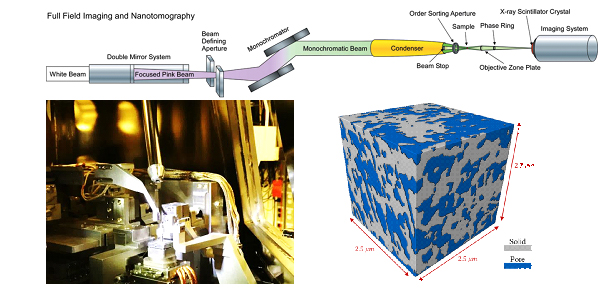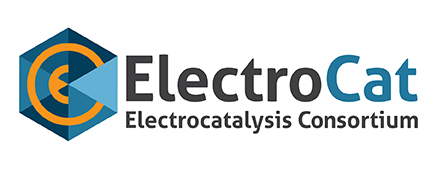| Laboratory: | Argonne National Laboratory |
| Capability Expert(s): | Rajesh K. Ahluwalia, Debbie Myers, Vincent J. De Andrade, and Robert Winarski |
| Capability Details: | |
| Title: | Electrode microstructure characterization and simulation |
| Class: | Computational and characterization tool |
| Description: | This capability encompasses structural imaging of electrodes, using synchrotron X-rays, combined with characterization via other techniques such as porosimetry and ultra-small angle X-ray scattering (USAXS), and use of these data from multiple techniques to build a structural and transport model of the electrode. Transmission X-ray microscopes (TXMs) at the Advanced Photon Source (APS) have the resolution, sensitivity and speed to provide practical and useful in-situ information about the microstructure of fuel cell electrodes. TXM is a full-field imaging instrument that acquires snapshot images of absorption or phase contrasts inside electrode samples with 2D detectors. It is equipped with a rotary stage that enables image acquisition over 180° and makes it possible to perform X-ray nano-computed tomography (XCT). In the XCT process, algorithms are used to reconstruct the images of volumes whose voxels correspond to linear attenuation coefficients. A hybrid computational method can combine the solid and secondary pore structures obtained from XCT with the catalyst size and composition distributions obtained from electron microscopy and primary pore size distribution obtained from porosimetry. The combined information fully defines the electrode microstructure that can then be input to multi-physics computational fluid dynamic (CFD) models to determine transport properties and electrochemical performance. |
| Capability Bounds: | Hard X-rays can penetrate and image the full thickness of non-PGM electrodes. The resolution of X-ray instruments and electron microscopes is currently limited to about 12.5 nm with phase contrast and about 21.7 nm without phase contrast. |
| Unique Aspects: | Two unique aspects of this capability are the high resolution of XCT data acquired using an insertion device beam line at a third-generation synchrotron source and the speed with which the data can be acquired versus a commercial laboratory XCT instrument. Other unique aspects are the use of a hybrid technique for simulation of 3-D electrode microstructures using information from XCT, SEM/TEM, USAXS, BET, and mercury intrusion porosimetry and a multi-physics model for electrode transport properties and performance using the simulated 3-D microstructure. |
| Availability: | There are two nanoprobe beamlines at the APS: 26-ID and 32-ID. Time on these beam lines is available either by directly applying to the APS (32-ID; Vincent De Andrade, beam line scientist; https://www1.aps.anl.gov/users-information/about-proposals/apply-for-time), via the Center for Nanoscale Materials (26-ID, Robert Winarski, beam line scientist, https://pico.cnm.anl.gov/proposals/people/login/proposal systems) or by coordinating with Debbie Myers. The use of multiple techniques, including USAXS and BET, for electrode structural and transport modeling and the modeling itself are available through the experimental and modeling capabilities in the Myers and Ahluwalia groups. |
| References: |
Vincent De Andrade, Alex Deriy, Michael J. Wojcik, Doga Gursoy, Deming Shu, Kamel Fezzaa, and Francesco De Carlo, “Nanoscale 3D imaging at the Advanced Photon Source,” 2016 SPIE Newsroom, DOI 10.1117/2.1201604.006461. Robert P. Winarski, Martin V. Holt, Volker Rose, Peter Fuesz, Dean Carbaugh, Christa Benson, Deming Shu, David Kline, G. Brian Stephenson, Ian McNulty, and Jorg Maser, “A hard X-ray nanoprobe beamline for nanoscale microscopy,” J. Synchrotron Rad. (2012). 19, 1056–1060. C. Firat Cetinbas, Rajesh Ahluwalia, Nancy Kariuki, Karren More, David Cullen, Brian Sneed, Robert Winarski, Jan Ilavsky, Vincent De Andrade, and Deborah Myers, “Structural Characterization and Transport Modeling of Pt and Pt Alloy Polymer Electrolyte Fuel Cell Cathode Catalyst Layers,” PRiME 2016, The Electrochemical Society, Abstract I01-2598. “Rationally Designed Catalyst Layers for PEMFC Performance Optimization,” Deborah J. Myers (Primary Contact), Nancy N. Kariuki, Rajesh Ahluwalia, Xiaohua Wang, and Jui-Kun Peng, FY 2015 Progress Reports for the Hydrogen and Fuel Cell Technologies Office, U.S. Department of Energy. “Rationally Designed Catalyst Layers for PEMFC Performance Optimization,” Debbie Myers and Nancy Kariuki, Rajesh Ahluwalia, Xiaohua Wang, C. Firat Cetinbas, and Jui-Kun Peng, FY 2016 Annual Merit Review Presentation, Washington D.C., June 6-10, 2016. |
| Benefit: | This capability is important to the mission of ElectroCat since knowledge of the structure and kinetic and transport processes that limit the electrochemical performance is crucial in the rational development of non-PGM catalysts and electrodes. Further understanding the relationship between the processing steps and the resulting electrode microstructure is also crucial. |

